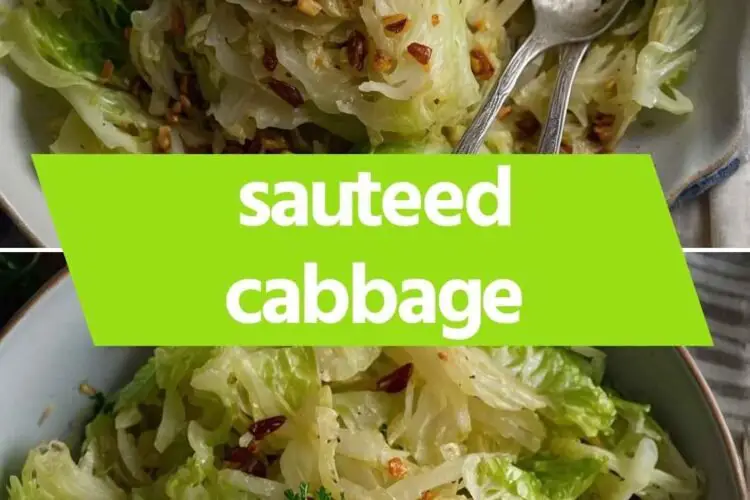Sauteed cabbage is not just a standalone dish; it can elevate a variety of meals. Picture this: it’s a warm summer evening, and you’ve grilled some juicy, tender chicken breasts. Add a generous serving of sauteed cabbage on the side, and you have a meal that sings comfort. If seafood is on your menu, this dish pairs beautifully with pan-seared salmon—the earthy flavors of the cabbage enhance the richness of the fish.
For a vegetarian option, consider serving it alongside a hearty grain bowl filled with quinoa, roasted vegetables, and a tangy tahini dressing. Even simple grilled sausage can find a home next to this delightful vegetable. The slightly sweet notes of the cabbage balance the spice of the sausage perfectly.
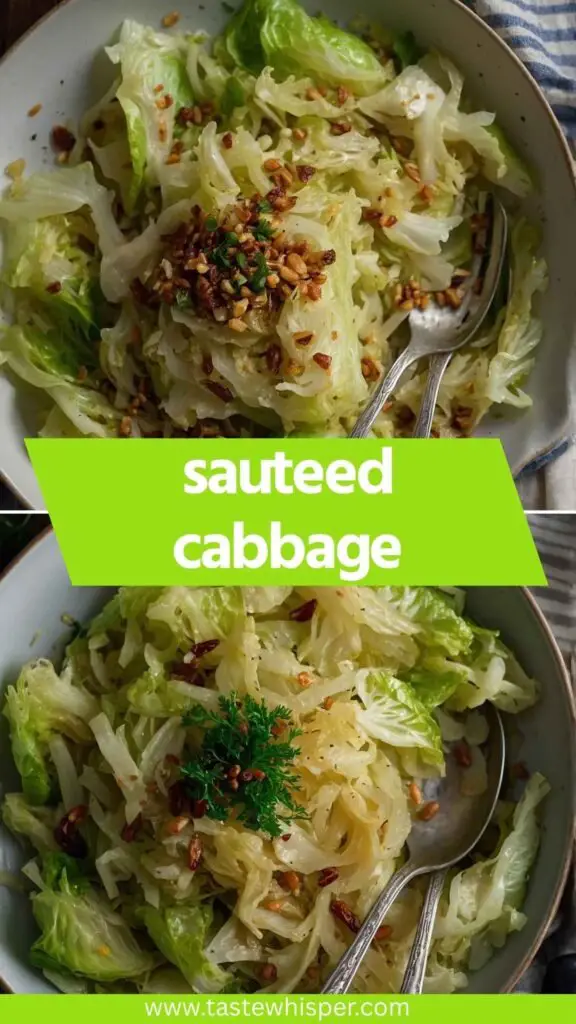
You’ll Also Like These Recipes
Sauteed cabbage may not be the flashiest dish on your dinner table, but it holds a treasure trove of flavors and textures that deserve a spotlight. I remember the first time I truly appreciated this humble vegetable. I was at a friend’s potluck, and there it was—a giant bowl of beautifully caramelized cabbage. One bite, and I was hooked.
Cabbage has a reputation for being bland, often relegated to the sidelines in salads or coleslaw. However, when you take the time to sauté it to perfection, it transforms into a dish that’s vibrant and appealing.
Plus, it’s healthy, inexpensive, and incredibly easy to prepare. In this comprehensive guide, we’ll explore the ins and outs of sauteed cabbage, including how to make it shine on your plate.
What is Sauteed Cabbage?
Sauteed cabbage is simply cabbage that’s been cooked quickly in a hot pan with a bit of fat. The objective is to achieve a tender texture with some caramelization, enhancing its natural sweetness. In just a few minutes, cabbage can go from a crisp, crunchy vegetable to a soft, flavorful side dish.
This cooking method allows for high temperature cooking, which can develop complex flavors and textures.
What is the Flavor Profile of this Dish?
The flavor profile of sauteed cabbage is pleasantly surprising. First, there’s the inherent sweetness of the cabbage, which intensifies with cooking. Then, when you add a bit of salt, it draws out even more flavor. The incorporation of garlic powder adds depth, while a splash of apple cider vinegar brings a bright acidity.
Smoked paprika can introduce a hint of warmth, and if you sprinkle in some fresh thyme, you’ll get an aromatic lift, creating a delicate balance of sweet, savory, and slightly tangy flavors. It’s a delightful medley that can appeal to many palates.
Why You’ll Love This?
You might be wondering why you should invest time in cooking cabbage. Here are a few compelling reasons:
Nutritional Powerhouse: Cabbage packs a punch with tons of vitamins C and K. It’s also high in fiber, making it great for digestion.
Budget-Friendly: Cabbage is one of the most economical vegetables you can buy, often costing less than a dollar per pound.
Versatility and Customization: It can be paired with various spices and flavors, allowing you to customize it endlessly.
Quick and Easy: This is a no-fuss dish that you can whip up in 10-15 minutes. Perfect for weeknight dinners!
Delicious Leftovers: Leftover sauteed cabbage can be enjoyed in sandwiches, salads, or even breakfast scrambles the next day.
Ingredients
- 1 tablespoon high-quality extra-virgin olive oil
- 1 teaspoon garlic powder (for depth of flavor)
- 1 tablespoon creamy unsalted butter
- ½ tablespoon apple cider vinegar, plus a splash more if desired
- 1 small head of crisp green cabbage, weighing around 2 ½ pounds
- ¼ teaspoon smoked paprika (for a subtle smoky warmth)
- 1 tablespoon finely chopped fresh thyme (optional)
- 1 ½ teaspoons kosher salt
- ½ teaspoon freshly cracked black pepper
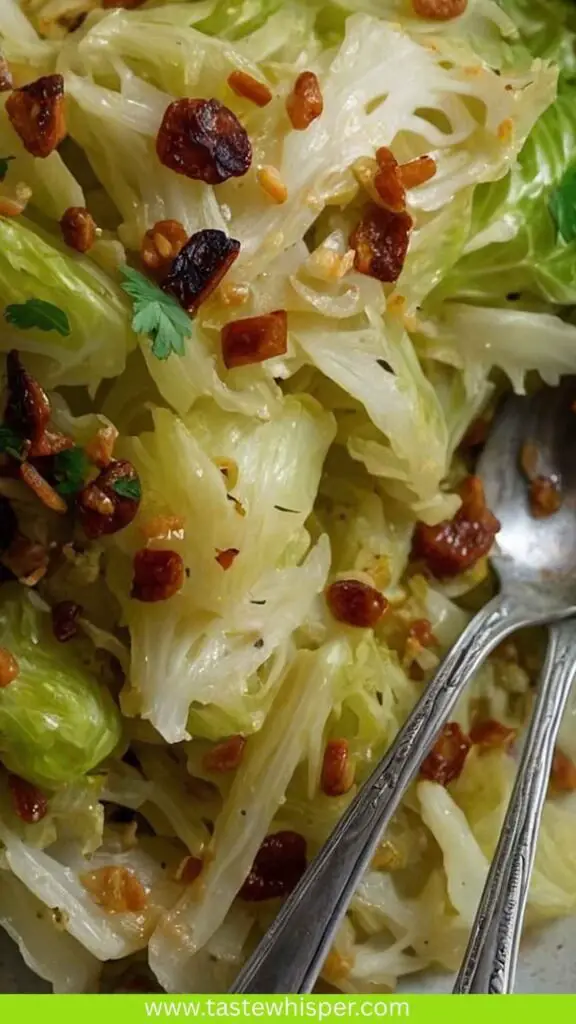
Step by Step Instructions
Step 1: Prepare the Cabbage
Start by removing the outer leaves from the cabbage. Rinse it under cold water to get rid of dirt and debris. Cut the cabbage in half, and remove the core. Slice each half into thin strips, about ½ inch wide.
Step 2: Heat the Pan
In a large skillet, heat the olive oil and butter over medium heat. Allow the butter to melt completely, combining with the oil. The oil prevents the butter from burning and gives a rich flavor.
Step 3: Add the Cabbage
Once the butter is melted and the oil is hot, carefully add the sliced cabbage to the pan. It might sizzle as the moisture from the cabbage meets the pan. Don’t overcrowd the pan; if necessary, cook in batches.
Step 4: Season It Up
Sprinkle the salt and garlic powder over the cabbage. Gently stir to ensure an even coating. Let the cabbage cook undisturbed for about 3-4 minutes. This builds up that delicious caramelization.
Step 5: Give it a Stir
After a few minutes, give the cabbage a good stir. You want to turn it over so that all the pieces get that lovely brown color. Allow it to cook for another 3-4 minutes.
Step 6: Add Spices and Acidity
Once the cabbage is tender and nicely browned, sprinkle in the smoked paprika and stir. Add the apple cider vinegar for a tangy kick. If you decide to use fresh thyme, now is the time to toss it in.
Step 7: Finish Cooking
Continue to stir and cook the cabbage for another minute to let the flavors meld. Taste and adjust seasoning if necessary. If you prefer a stronger vinegar flavor, add a little splash more.
Tips & Tricks
Cut Evenly: Ensure the cabbage is cut uniformly to promote even cooking.
Use a Large Pan: A larger surface area helps with better caramelization.
Experiment with Spices: Don’t hesitate to play around with different spices, like cumin or red pepper flakes, for extra flavor.
Add Proteins: For a complete meal, consider adding sautéed sausages or tofu along with cabbage.
Don’t Rush: Allow the cabbage to cook without constant stirring for that lovely browning.
Nutrition Information
This recipe serves about four people, and here’s a rough breakdown of the nutritional information per serving:
Calories: 100
Protein: 2g
Fat: 7g
Carbohydrates: 8g
Fiber: 4g
Sugar: 3g
This makes it an excellent addition to any meal, providing fiber and vitamins without overwhelming calories.
How Can You Store This Sauteed Cabbage?
If you’ve made a batch and have leftovers, storing it is easy. Transfer the sauteed cabbage to an airtight container and refrigerate. It should keep well for up to 3-5 days. You can also freeze it if you want to extend its shelf life. Just make sure to cool it completely before transferring to a freezer-safe container.
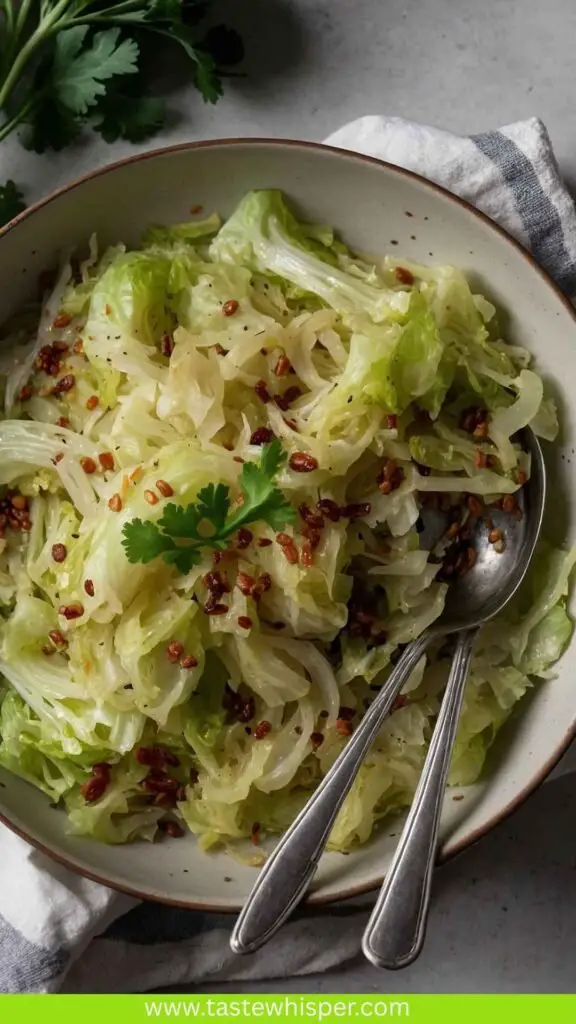
Alternative Ingredient Suggestions
If you find yourself short on some ingredients, don’t fret! Here are a few alternatives you can consider:
Olive Oil Substitute: If you lack extra-virgin olive oil, avocado oil works well too. It has a high smoke point and offers a mild flavor.
Butter Alternative: For a dairy-free version, use coconut oil or a plant-based butter. Both provide a nice richness to the dish.
Apple Cider Vinegar Option: If you don’t have apple cider vinegar, a splash of lemon juice or rice vinegar can bring the necessary acidity to brighten the flavors.
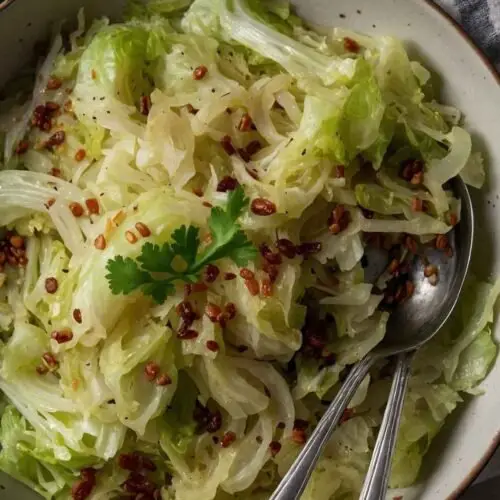
Sauteed Cabbage
Equipment
- Skillet, Pan
Ingredients
- 1 tablespoon high-quality extra-virgin olive oil
- 1 teaspoon garlic powder for depth of flavor
- 1 tablespoon creamy unsalted butter
- ½ tablespoon apple cider vinegar plus a splash more if desired
- 1 small head of crisp green cabbage weighing around 2 ½ pounds
- ¼ teaspoon smoked paprika for a subtle smoky warmth
- 1 tablespoon finely chopped fresh thyme optional
- 1 ½ teaspoons kosher salt
- ½ teaspoon freshly cracked black pepper
Instructions
Step 1: Prepare the Cabbage
- Start by removing the outer leaves from the cabbage. Rinse it under cold water to get rid of dirt and debris. Cut the cabbage in half, and remove the core. Slice each half into thin strips, about ½ inch wide.
Step 2: Heat the Pan
- In a large skillet, heat the olive oil and butter over medium heat. Allow the butter to melt completely, combining with the oil. The oil prevents the butter from burning and gives a rich flavor.
Step 3: Add the Cabbage
- Once the butter is melted and the oil is hot, carefully add the sliced cabbage to the pan. It might sizzle as the moisture from the cabbage meets the pan. Don’t overcrowd the pan; if necessary, cook in batches.
Step 4: Season It Up
- Sprinkle the salt and garlic powder over the cabbage. Gently stir to ensure an even coating. Let the cabbage cook undisturbed for about 3-4 minutes. This builds up that delicious caramelization.
Step 5: Give it a Stir
- After a few minutes, give the cabbage a good stir. You want to turn it over so that all the pieces get that lovely brown color. Allow it to cook for another 3-4 minutes.
Step 6: Add Spices and Acidity
- Once the cabbage is tender and nicely browned, sprinkle in the smoked paprika and stir. Add the apple cider vinegar for a tangy kick. If you decide to use fresh thyme, now is the time to toss it in.
Step 7: Finish Cooking
- Continue to stir and cook the cabbage for another minute to let the flavors meld. Taste and adjust seasoning if necessary. If you prefer a stronger vinegar flavor, add a little splash more.
Notes
Use a Large Pan: A larger surface area helps with better caramelization.
Experiment with Spices: Don’t hesitate to play around with different spices, like cumin or red pepper flakes, for extra flavor.
Add Proteins: For a complete meal, consider adding sautéed sausages or tofu along with cabbage.
Don’t Rush: Allow the cabbage to cook without constant stirring for that lovely browning.
Nutrition
Frequently Asked Questions
Can I use purple cabbage instead of green?
Absolutely! Purple cabbage offers a slightly sweeter taste and adds a beautiful color. The cooking method remains the same, so feel free to swap.
Is sauteed cabbage suitable for meal prep?
Yes! This cabbage holds up well in the refrigerator and makes a great addition to meal prep containers. Just reheat it in the skillet or microwave before serving.
What can I add for extra protein?
Consider adding sliced grilled chicken, chickpeas, or even beans to the sauteed cabbage for a protein boost.
Is this dish gluten-free?
Yes, cabbage is naturally gluten-free. You can serve it alongside gluten-free grains for a wholesome meal.
How do I know when the cabbage is cooked enough?
You’ll know the cabbage is done when it’s tender but still holds some structure. If you prefer a softer texture, continue cooking until it reaches your desired doneness.
Conclusion
Sauteed cabbage may seem like a simple recipe, but its depth of flavor and versatility can’t be overlooked. Whether served as a side dish or a main component of a meal, it adds character and nutrition to your plate. Embrace the process of cooking this delightful vegetable, and you might find yourself transforming many a meal with its subtle yet satisfying taste.
So gear up, grab a head of cabbage, and have fun experimenting in your kitchen. Not only will you whip up a healthy dish in no time, but your taste buds will also thank you for it. Happy cooking!

